Search Result
Results for "
BBB permeability
" in MedChemExpress (MCE) Product Catalog:
1
Biochemical Assay Reagents
2
Isotope-Labeled Compounds
| Cat. No. |
Product Name |
Target |
Research Areas |
Chemical Structure |
-
- HY-128868G
-
|
|
Fluorescent Dye
|
Others
|
|
FITC-Dextran (MW 150000) is a fluorescent probe for fluorescein isothiocyanate (FITC) dextran (Ex=491 nm; Em=518 nm). FITC-Dextran (MW 150000) can be used as a marker to reveal heat shock-induced cell damage and to study the early and late stages of apoptosis. FITC-Dextran (MW 150000) can be used in perfusion studies in animals or in fluorescence microlymphography, to study processes that affect the permeability of the blood brain barrier (BBB) . FITC-Dextran (MW 150000) can be used as fluorescent probe to study cell permeability .
|
-

-
- HY-162277
-
|
|
Cholinesterase (ChE)
|
Neurological Disease
|
|
BuChE-IN-10 (compound 7p) is an inhibitor of BuChE (eqBuChE IC50 = 4.68 nM, huBuChE IC50 = 9.12 nM). BuChE-IN-10 has anti-neuroinflammatory activity and exhibits high BBB permeability .
|
-
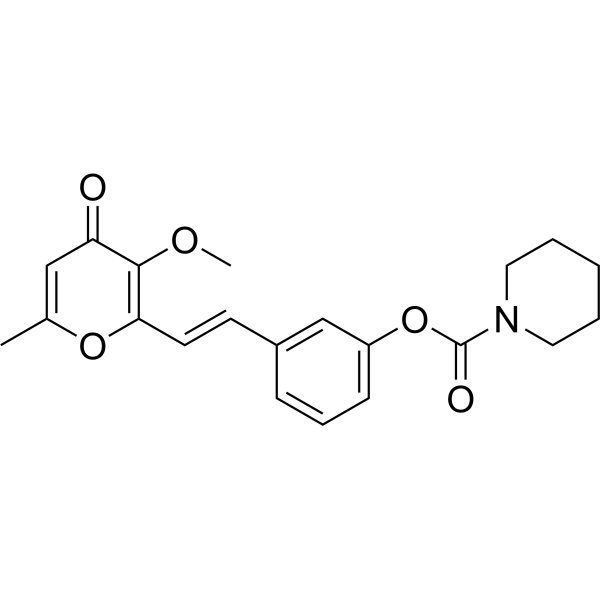
-
- HY-155271
-
|
|
Carbonic Anhydrase
|
Others
|
|
hCAXII-IN-7 (compound 6e) is a hCA XII inhibitor. hCAXII-IN-7 has BBB permeability. hCAXII-IN-7 induces 786-0, SF-539 and HS 578 T cells apoptotic .
|
-
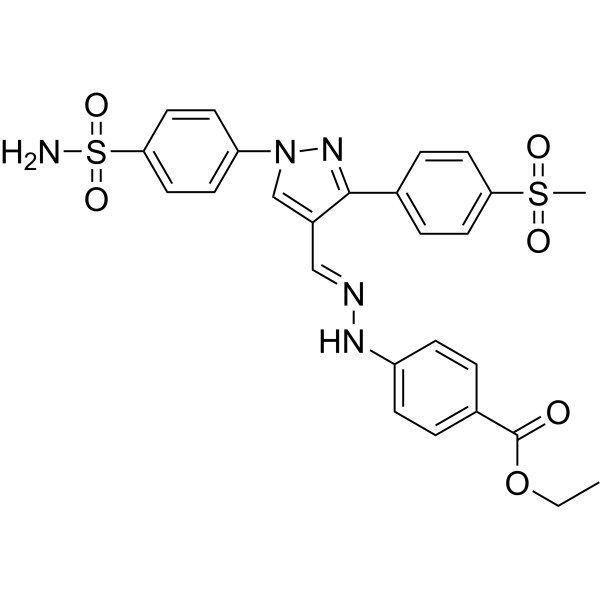
-
- HY-150545
-
|
|
Cholinesterase (ChE)
|
Neurological Disease
|
|
AChE-IN-21 (Compound I-8) is a potent, selective and orally active AChE inhibitor with an IC50 of 2.66 nM. AChE-IN-21 displays excellent BBB permeability in vitro .
|
-
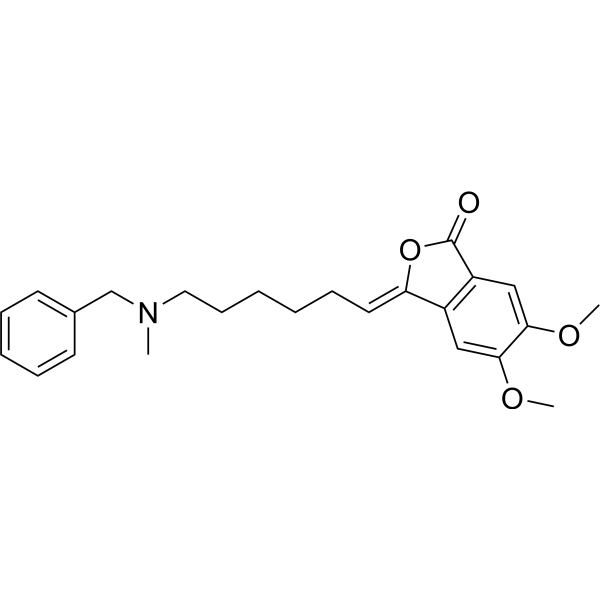
-
- HY-151962
-
|
|
JNK
Apoptosis
GSK-3
p38 MAPK
|
Neurological Disease
|
|
JNK3 inhibitor-5 (Compound 22b) is a potent and selective JNK3 inhibitor with an IC50 of 0.379 nM. JNK3 inhibitor-5 effectively protects the neuronal cells against amyloid beta-induced apoptosis. JNK3 inhibitor-5 has a high cell permeability and is predicted as BBB permeable .
|
-
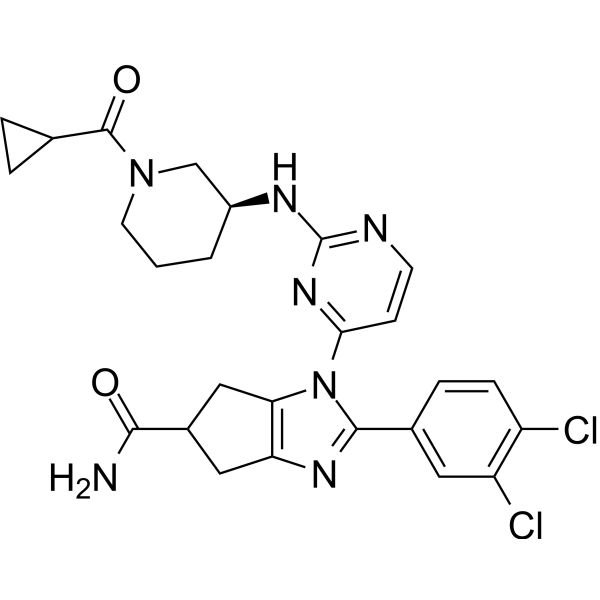
-
- HY-149941
-
|
|
Neurotensin Receptor
|
Neurological Disease
|
|
hNTS1R agonist-1 (Compound 10) is a BBB permeable hNTS1R full agonist (Ki: 6.9 nM) . hNTS1R agonist-1 increases motor function and memory in a mouse model of Parkinson's disease (PD). hNTS1R agonist-1 is a Neurotensin(8-13) analog and is a neuroprotective agent .
|
-

-
- HY-144660
-
|
|
Cholinesterase (ChE)
|
Neurological Disease
|
|
AChE-IN-7 (Compound 16) is a selective and potent inhibitor of acetylcholinesterase (eeAChE IC50 = 0.045 μM; eeBuChE IC50 = 19.68 μM). AChE-IN-7 is safe in vivo and in vitro, and shows good overall pharmacokinetic performance and high bioavailability (F = 55.5%). AChE-IN-7 also has high BBB permeability .
|
-

-
- HY-151261
-
|
|
HDAC
|
Inflammation/Immunology
|
|
HDAC6-IN-13 (Compound 35m) is a potent, highly selective, orally active HDAC6 inhibitor with an IC50 of 0.019 μM. HDAC6-IN-13 also inhibits HDAC1, HDAC2 and HDAC3 with IC50s of 1.53, 2.06 and 1.03 μM, respectively. HDAC6-IN-13 shows significant BBB permeability and anti-inflammatory activity .
|
-

-
- HY-158148
-
|
|
c-Fms
|
Neurological Disease
Inflammation/Immunology
|
|
CSF1R-IN-23 (Compound 7dri) is a selective inhibitor for colony-stimulating factor-1 receptor (CSF1R), with IC50 of 36.1 nM. CSF1R-IN-23 serves as antineuroinflammatory agent in mouse model. CSF1R-IN-23 is blood brain barrier (BBB) permeable .
|
-
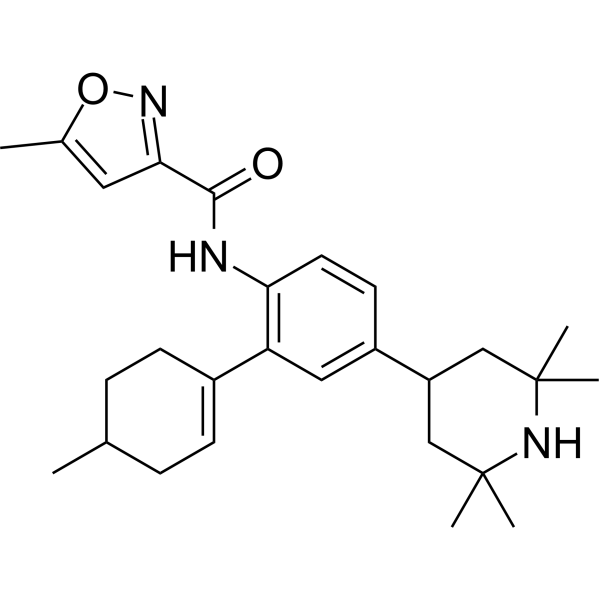
-
- HY-117983
-
|
|
Amyloid-β
|
Neurological Disease
|
|
RU-505 is an effective β-amyloid (Aβ)-fibrinogen interaction inhibitor with IC50s of 5.00 and 2.72 μM in fluorescence polarization (FP) and AlphaLISA assays, respectively. RU-505 is highly permeable to the BBB. RU-505 reduces cerebral amyloid angiopathy (CAA). RU-505 can be used for the research of Alzheimer’s disease (AD) .
|
-
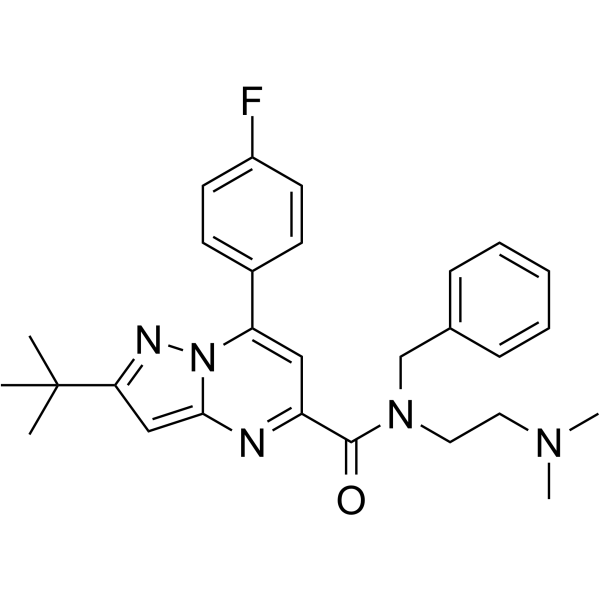
-
- HY-151928
-
|
|
JNK
|
Neurological Disease
|
|
JNK3 inhibitor-3 (compound 15g) is a selective, BBB permeable and orally active c-Jun N-terminal kinase 3 (JNK3) inhibitor. JNK3 inhibitor-3 has inhibitory activities to JNK1, JNK2 and JNK3 with IC50 values of 147.8, 44.0 and 4.1 nM, respectively. JNK3 inhibitor-3 significantly improves the memory in mouse dementia model. JNK3 inhibitor-3 can be used for the research of Alzheimer’s disease .
|
-
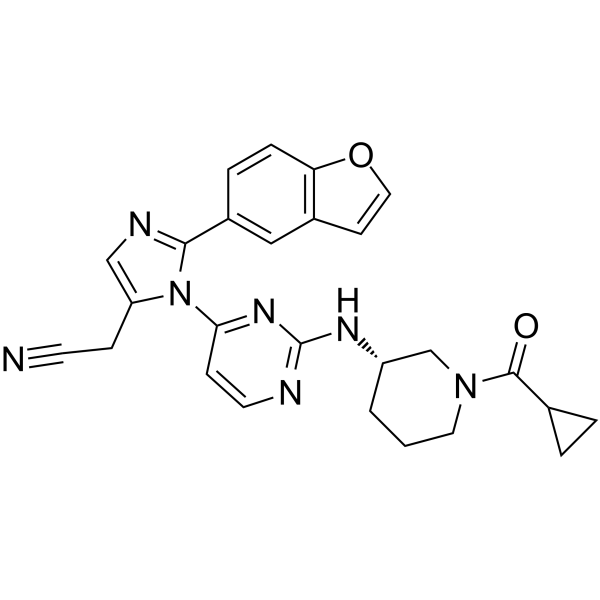
-
- HY-18738
-
|
Ammonium pyrrolidinedithiocarbamate; PDTC ammonium; APDC
|
NF-κB
|
Inflammation/Immunology
Cancer
|
|
Pyrrolidinedithiocarbamate ammonium (Ammonium pyrrolidinedithiocarbamate) is a selective and blood-brain barrier (BBB) permeable NF-κB inhibitor.
|
-
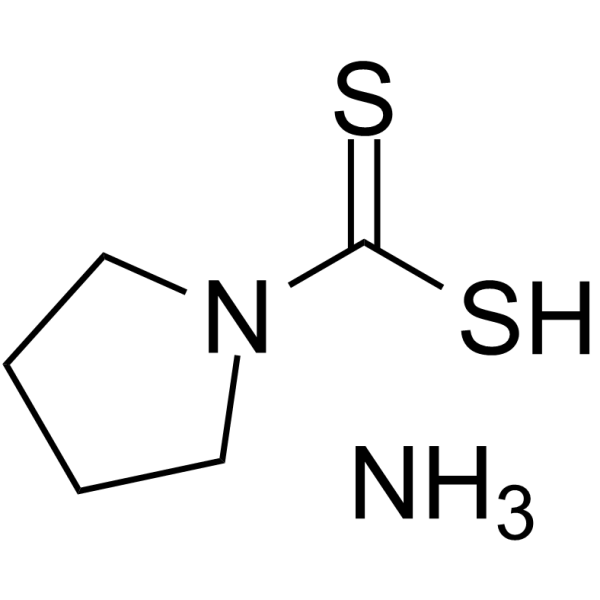
-
- HY-N6685
-
|
|
Others
|
Cardiovascular Disease
|
|
3-Acetyldeoxynivalenol, a trichothecene mycotoxin deoxynivalenol (DON) acetylated derivative , is a blood-brain barrier (BBB) permeable mycotoxin .
|
-
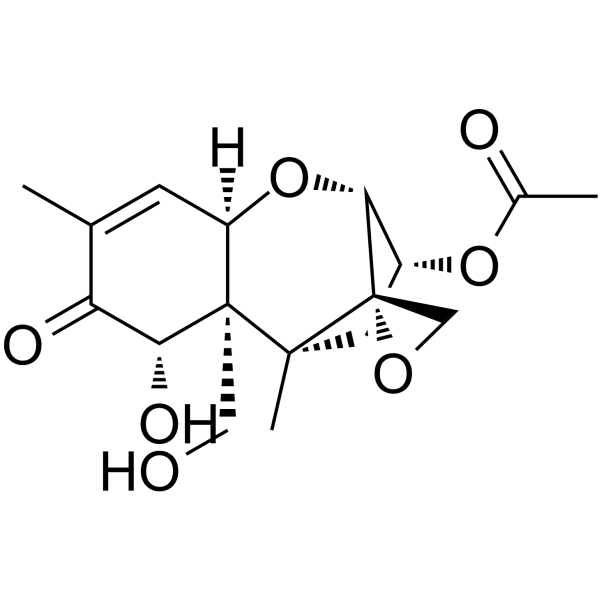
-
- HY-161666
-
-

-
- HY-158765
-
|
|
Others
|
Neurological Disease
|
|
Leuco ethyl violet is a photooxidation catalyst for amyloid selectivity and blood-brain barrier (BBB) permeability. Leuco ethyl violet can be used in the study of Alzheimer's disease (AD) .
|
-

-
- HY-18406
-
|
|
HSP
|
Cancer
|
|
HSP70-IN-4 (Compound YM-01) is an Hsp70 inhibitor with an IC50 of 3.2 μM. HSP70-IN-4 is not BBB permeable .
|
-
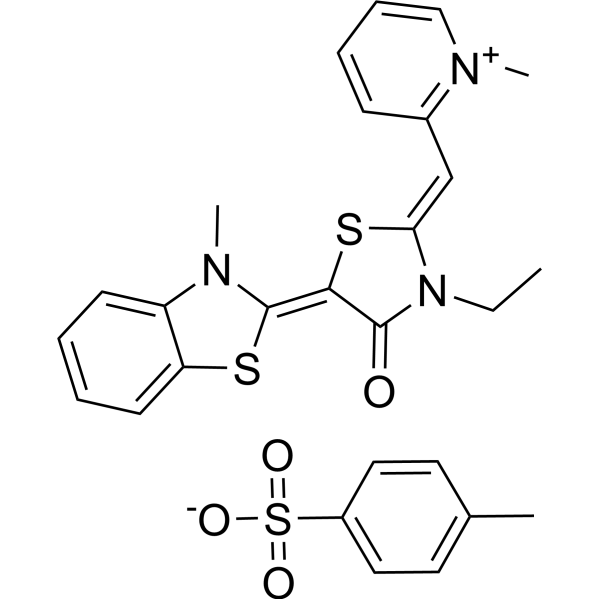
-
- HY-131340
-
|
|
Phosphodiesterase (PDE)
|
Inflammation/Immunology
|
|
LASSBio-1632 is a new anti-asthmatic lead candidate associated with selective inhibition of PDE4A and PDE4D isoenzymes and blockade of airway hyper-reactivity (AHR) and TNF-α production in the lung tissue. LASSBio-1632 (7j) displays high experimental BBB permeability across BBB through passive diffusion .
|
-
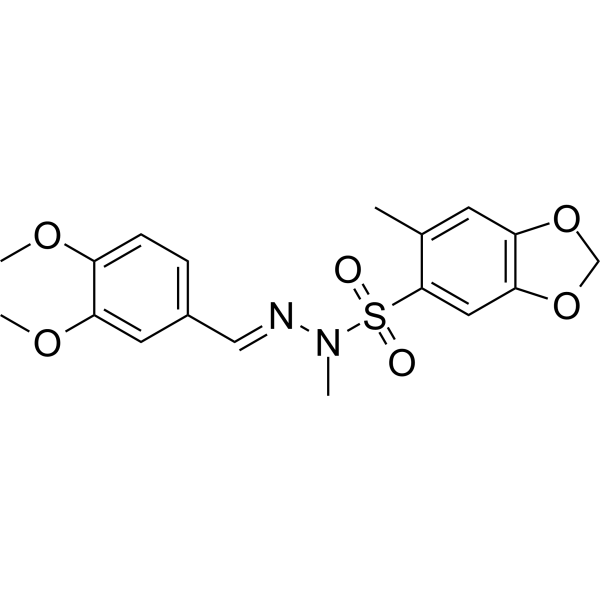
-
- HY-18749
-
SC79
Maximum Cited Publications
170 Publications Verification
|
Akt
|
Neurological Disease
Inflammation/Immunology
Cancer
|
|
SC79, a unique specific and BBB permeable Akt activator, activates Akt in the cytosol and inhibits Akt membrane translocation. SC79 specifically binds to the PH domain of Akt .
|
-
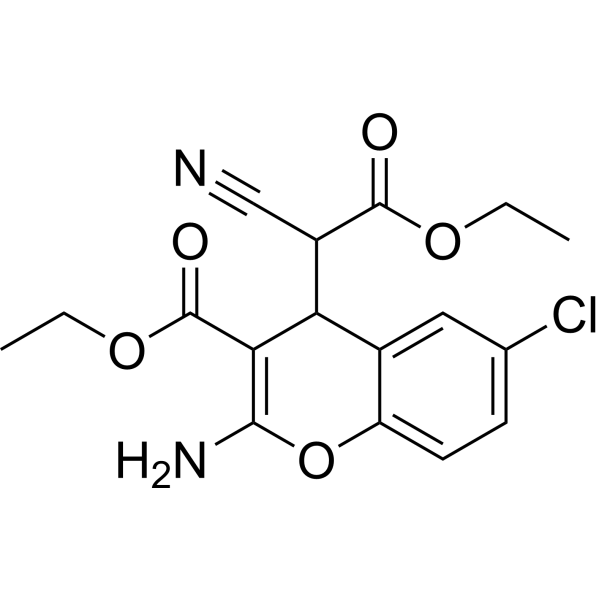
-
- HY-158693
-
|
|
Sigma Receptor
|
Neurological Disease
|
|
WLB-87848 is a selective, orally active, and blood-brain barrier (BBB) permeable σ1 receptor agonist with the Ki of 9 nM. WLB-87848 rescues recognition memory impairment .
|
-

-
- HY-105155
-
|
RMP 7
|
Bradykinin Receptor
|
Cancer
|
|
Lobradimil (RMP 7), a synthetic bradykinin analog, is a potent and selective bradykinin B2 receptor agonist (Ki: 0.54 nM). Lobradimil increases the permeability of the BBB. Lobradimil can be used in the research of brain tumors .
|
-
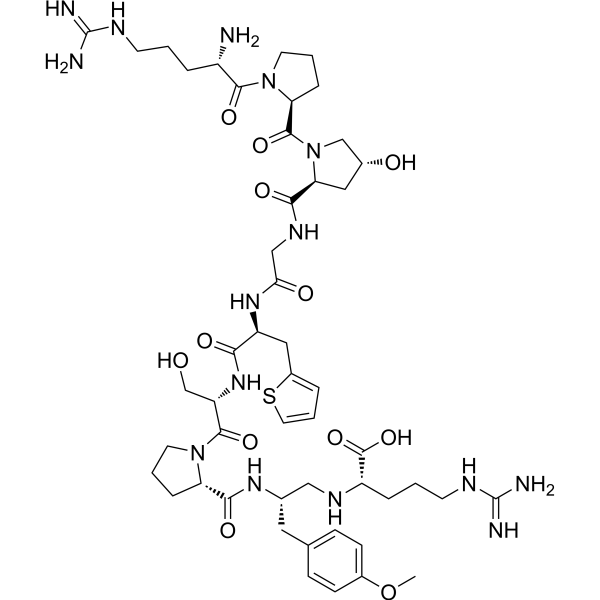
-
- HY-146049
-
|
|
Parasite
|
Infection
|
|
Antitrypanosomal agent 4 (compound 19) is a potent and blood-brain barrier permeable antitrypanosomal agent. Antitrypanosomal agent 4 has good activity against Trypanosoma cruzi (T. cruzi) and Trypanosoma brucei brucei (T. b. brucei) with IC50s of 1.2 μM and 70 nM, respectively . Antitrypanosomal agent 4 is a click chemistry reagent, it contains an Alkyne group and can undergo copper-catalyzed azide-alkyne cycloaddition (CuAAc) with molecules containing Azide groups.
|
-
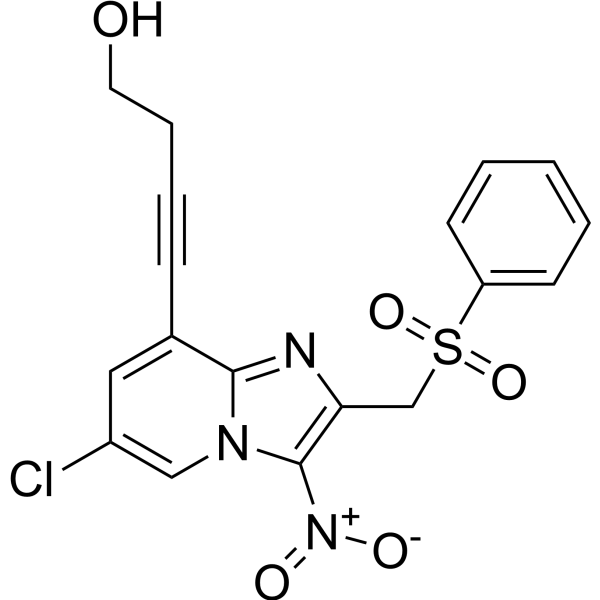
-
- HY-161683
-
|
|
JAK
|
Neurological Disease
|
|
Tyk2-IN-19 (compound 1) is an orally active and blood-brain barrier (BBB) permeable Tyk2 inhibitor. Tyk2-IN-19 can be used for study of neurodegenerative diseases .
|
-

-
- HY-146588
-
|
|
iGluR
|
Neurological Disease
|
|
NMDA receptor antagonist 4 (IIc) is a uncompetitive, voltage-dependent, orally active NMDAR blocker, with an IC50 of 1.93 µM. NMDA receptor antagonist 4 shows a positive predicted blood-brain-barrier (BBB) permeability, and can be studied in Alzheimer's disease .
|
-
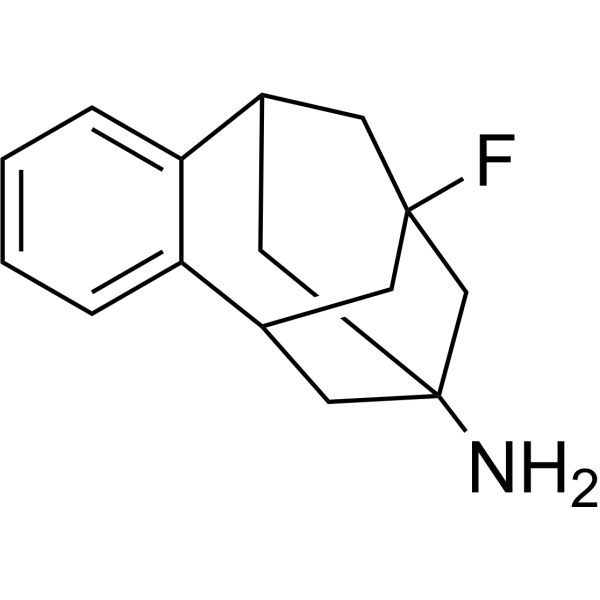
-
- HY-153773
-
|
|
IRE1
|
Cancer
|
|
Z4P is a BBB-permeable IRE1 inhibitor (IC50: 1.11 μM). Z4P inhibits Glioblastoma cell growth. Z4P prevents glioblastoma relapse when administered together with Temozolomide (HY-17364) .
|
-
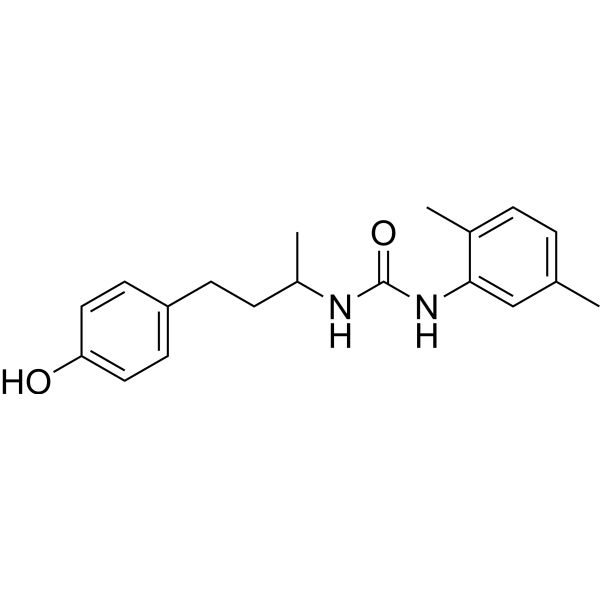
-
- HY-161256
-
|
|
Microtubule/Tubulin
Apoptosis
|
Cancer
|
|
Tubulin inhibitor 41 (Compd D19), a promising anti-GBM (glioblastoma) lead compound and tublin inhibitor with BBB permeability, induces G2/M phase arrest, resulted in cell apoptosis and inhibits the migration of U87 cells .
|
-

-
- HY-128868
-
|
|
Fluorescent Dye
|
Others
|
|
FITC-Dextran (MW 10000) is a fluorescent probe for fluorescein isothiocyanate (FITC) dextran (Ex=495 nm; Em=525 nm). FITC-Dextran (MW 10000) can be used as a marker to reveal heat shock-induced cell damage and to study the early and late stages of apoptosis. FITC-Dextran (MW 10000) can also be used for cell permeability studies, such as blood-brain barrier permeability and determination of the extent of blood-brain barrier disruption .
|
-

-
- HY-118152
-
|
|
5-HT Receptor
|
Neurological Disease
|
|
Org-12962 is a potent, selective and orally active 5-HT2C receptor agonist with a pEC50 value of 7.01. Org-12962 also exhibits high effacy for the 5-HT2A and 5-HT2B receptor with pEC50s of 6.38 and 6.28, respectively .Org-12962 displays antiaversive effects in a rat model of panic-like anxiety .
|
-
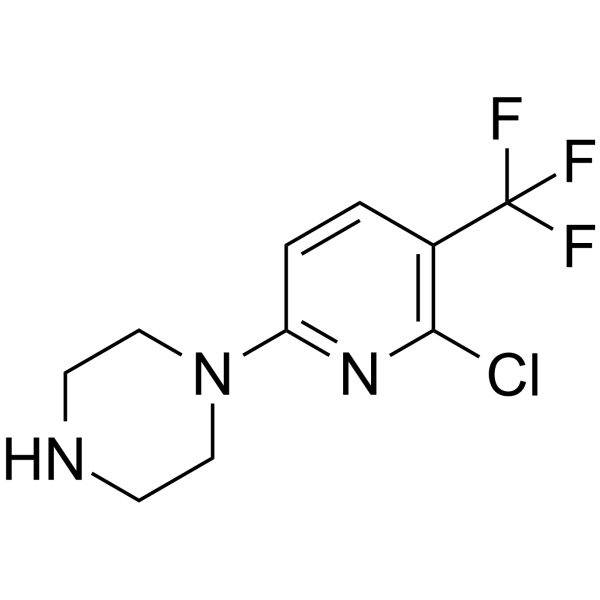
-
- HY-128868A
-
|
|
Fluorescent Dye
|
Others
|
|
FITC-Dextran (MW 4000) is a fluorescent probe for fluorescein isothiocyanate (FITC) dextran (Ex=495 nm; Em=525 nm). FITC-Dextran (MW 4000) can be used as a marker to reveal heat shock-induced cell damage and to study the early and late stages of apoptosis. FITC-Dextran (MW 4000) can also be used for cell permeability studies, such as blood-brain barrier permeability and determination of the extent of blood-brain barrier disruption .
|
-

-
- HY-21994
-
|
|
5-HT Receptor
|
Neurological Disease
|
|
Org 12962 hydrochloride is a potent, selective and efficacious 5-HT2C receptor agonist and exhibits pEC50 values of 7.01, 6.38 and 6.28 for 5-HT2C, 5-HT2A and 5-HT2A, respectively. Org 12962 hydrochloride is effective in panic-like anxiety animal model .
|
-
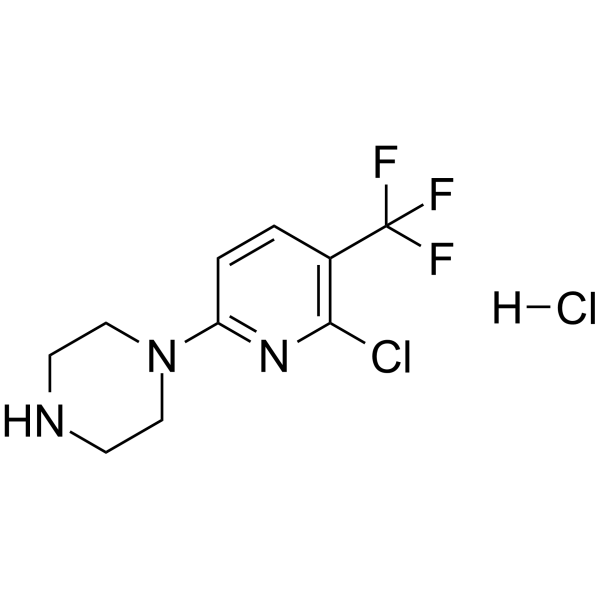
-
- HY-141660
-
-

-
- HY-128868D
-
|
|
Fluorescent Dye
|
Others
|
|
FITC-Dextran (MW 40000) is a fluorescent probe for fluorescein isothiocyanate (FITC) dextran (Ex=495 nm; Em=525 nm). FITC-Dextran (MW 40000) can be used as a marker to reveal heat shock-induced cell damage and to study the early and late stages of apoptosis. FITC-Dextran (MW 40000) can also be used for cell permeability studies, such as blood-brain barrier permeability and determination of the extent of blood-brain barrier disruption .
|
-

-
- HY-N6685S1
-
|
|
Isotope-Labeled Compounds
|
Cardiovascular Disease
|
|
3-Acetyldeoxynivalenol- 13C17 is the 13C labeled 3-Acetyldeoxynivalenol (HY-N6685) . 3-Acetyldeoxynivalenol, a trichothecene mycotoxin deoxynivalenol (DON) acetylated derivative , is a blood-brain barrier (BBB) permeable mycotoxin .
|
-
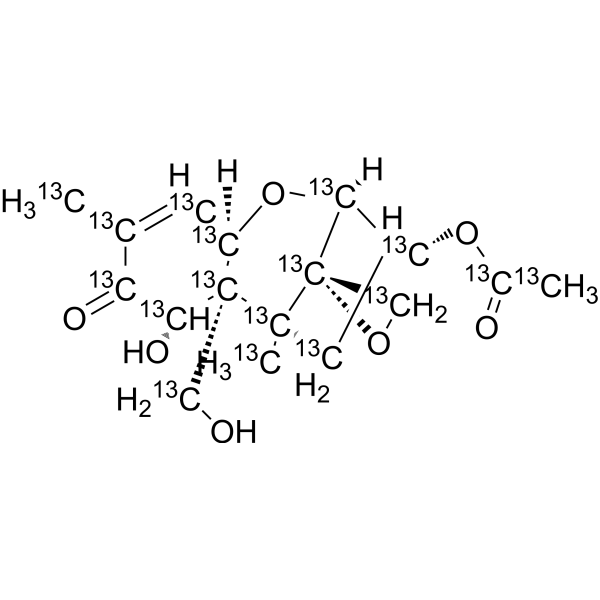
-
- HY-149820
-
|
|
Monoamine Oxidase
|
Neurological Disease
|
|
MAO-B-IN-22 (compound 6h) is a potent MAO-B inhibitor with an IC50 of 0.014 μM. MAO-B-IN-22 has high antioxidant activity, good metal chelating ability, proper BBB permeability and significant neuroprotective effect .
|
-
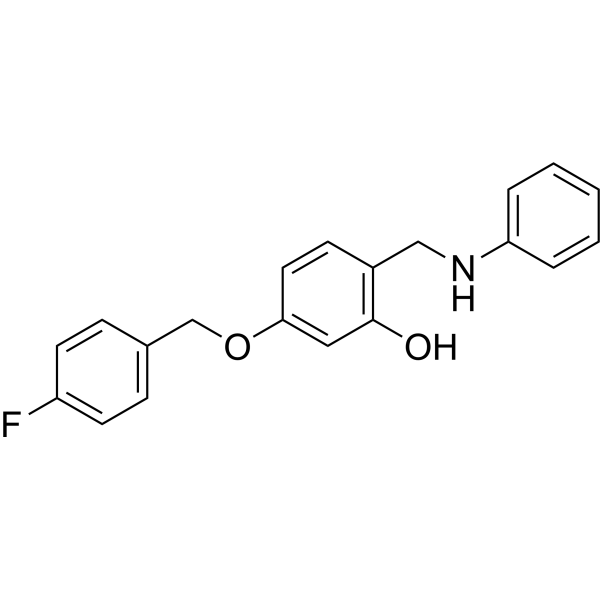
-
- HY-149212
-
|
|
Cholinesterase (ChE)
|
Neurological Disease
|
|
SD-6 is an orally active inhibitor of hAChE and hBChE with IC50 values of 0.907 µM and 1.579 µM, respectively. SD-6 has excellent blood-brain barrier (BBB) permeability and no neurotoxicity, which can be used for research on Alzheimer's disease .
|
-
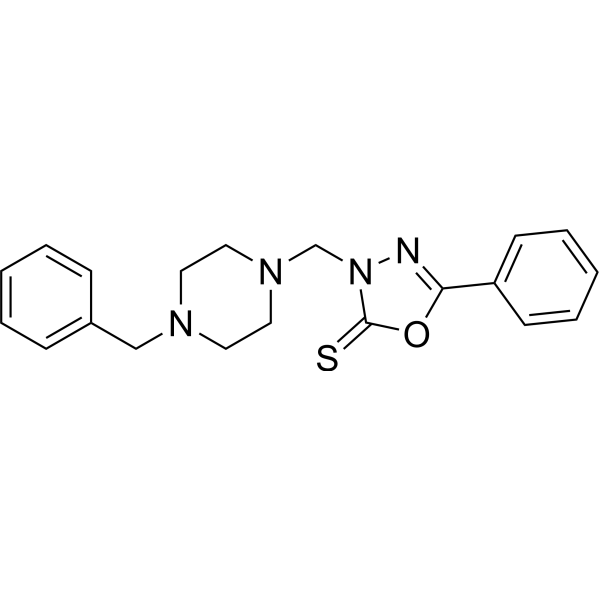
-
- HY-160168
-
-
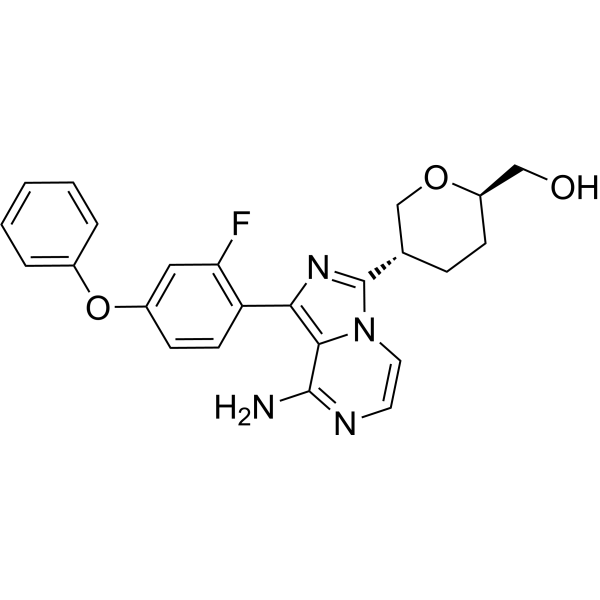
-
- HY-155939
-
|
|
TGF-β Receptor
|
Cancer
|
|
M4K2163 dihydrochloride is a potent, selective, blood-brain barrier (BBB) permeable activin receptor-like kinase-2 (ALK2) inhibitor, with an IC50 of 19 nM. M4K2163 dihydrochloride can be used in the research of diffuse intrinsic pontine glioma (DIPG) .
|
-

-
- HY-144765
-
|
|
NF-κB
Apoptosis
|
Neurological Disease
Inflammation/Immunology
|
|
NF-κB-IN-4 (compound 17) is a potent and BBB-penetrated NF-κB pathway inhibitor with blood brain barrier (BBB) permeability. NF-κB-IN-4 exhibits potential anti-neuroinflammatory activity with low toxicity. NF-κB-IN-4 can block the activation and phosphorylation of IκBα, reduce expression of NLRP3, and thus inhibit NF-κB activation. NF-κB-IN-4 can be used for neuroinflammation related diseases research .
|
-

-
- HY-A0168A
-
|
CVT-3146 hydrate
|
Adenosine Receptor
|
Cardiovascular Disease
|
|
Regadenoson hydrate (NSC 169186) is a selective A2A adenosine receptor agonist and vasodilator that increases coronary blood flow, can be used in study of myocardial perfusion imaging. Regadenoson hydrate also increases the permeability of the blood-brain barrier (BBB) in rodents, can be used to study increased delivery of agents to the human CNS .
|
-

-
- HY-A0168
-
|
CVT-3146
|
Adenosine Receptor
|
Cardiovascular Disease
|
|
Regadenoson (CVT-3146) is a selective A2A adenosine receptor agonist and vasodilator that increases coronary blood flow, can be used in study of myocardial perfusion imaging. Regadenoson also increases the permeability of the blood-brain barrier (BBB) in rodents, can be used to study increased delivery of agents to the human CNS .
|
-
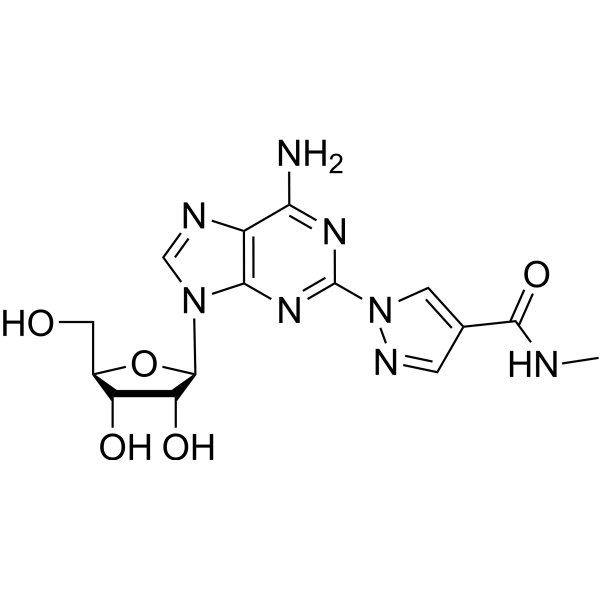
-
- HY-144446
-
|
|
Cholinesterase (ChE)
|
Neurological Disease
|
|
BuChE-IN-1 (Compound 23) is a potent inhibitor of butyrylcholinesterase (BuChE). Butyrylcholinesterase (BuChE) is recently regarded as a biomarker in progressed Alzheimer’s disease (AD). BuChE-IN-1 shows low cytotoxicity and high blood brain barrier (BBB) permeability. BuChE-IN-1 is a promising BuChE inhibitor for the research of AD .
|
-
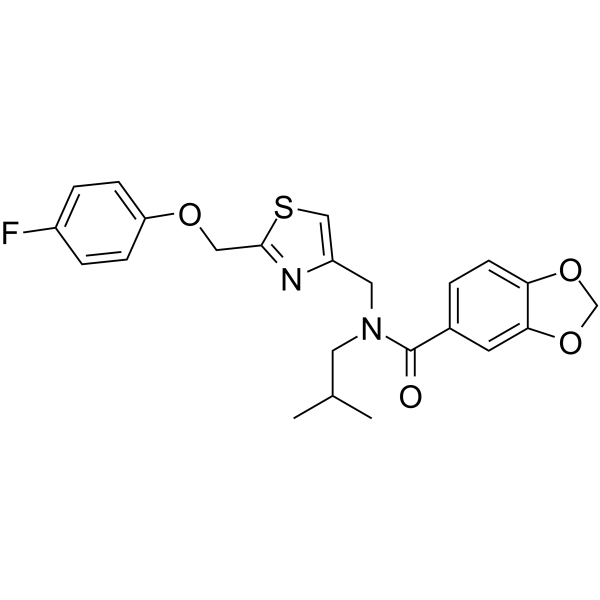
-
- HY-156432
-
|
|
Anaplastic lymphoma kinase (ALK)
mTOR
PARP
Caspase
|
Cancer
|
|
ALK-IN-26 is an ALK inhibitor with IC50 value of 7.0 μM for ALK tyrosine kinase. ALK-IN-26 has good pharmacokinetic properties and blood-brain barrier (BBB) permeability. ALK-IN-26 can induce apoptosis, autophagy and necrosis. ALK-IN-26 can be used in glioblastoma studies .
|
-
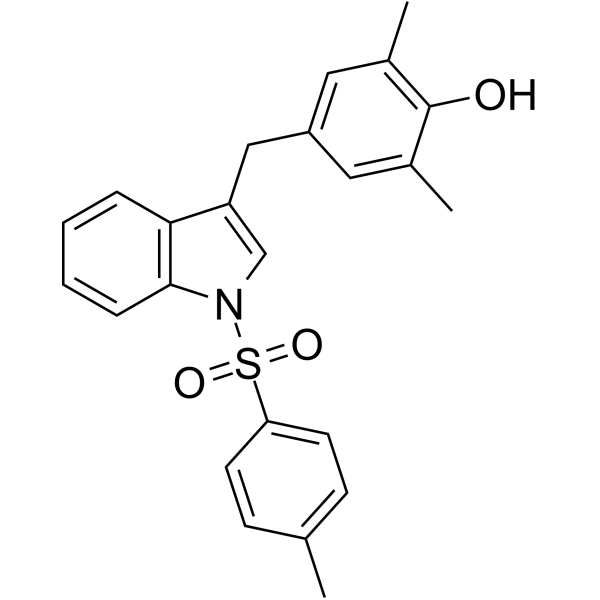
-
- HY-163415
-
|
|
Monoamine Oxidase
|
Neurological Disease
|
|
MAO-IN-5 (Compound ZINC000016952895) is a monoamine oxidase (MAO) inhibitor. According to the prediction of Swiss ADME, MAO-IN-5 can inhibit the CYP enzyme family, has blood-brain barrier (BBB) permeability, and has a high gastrointestinal absorption rate. MAO-IN-5 can be used in the study of neurological diseases .
|
-
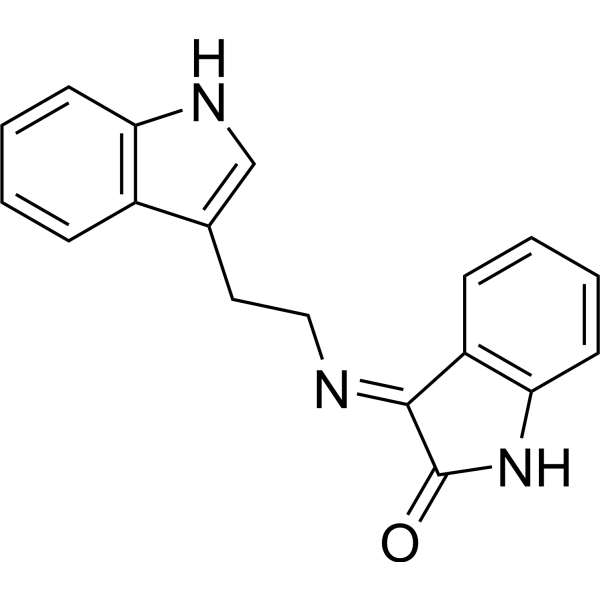
-
- HY-124160
-
|
|
iGluR
|
Neurological Disease
|
|
JNJ-56022486 is an orally active and potent negative AMPA receptor modulator (Ki=19 nM) selective for?TARP-γ8. JNJ-56022486 is also a TARP-γ8 receptor antagonist, with blood?brain?barrier (BBB) permeability. JNJ-56022486 can be used for research of Epilepsy .
|
-
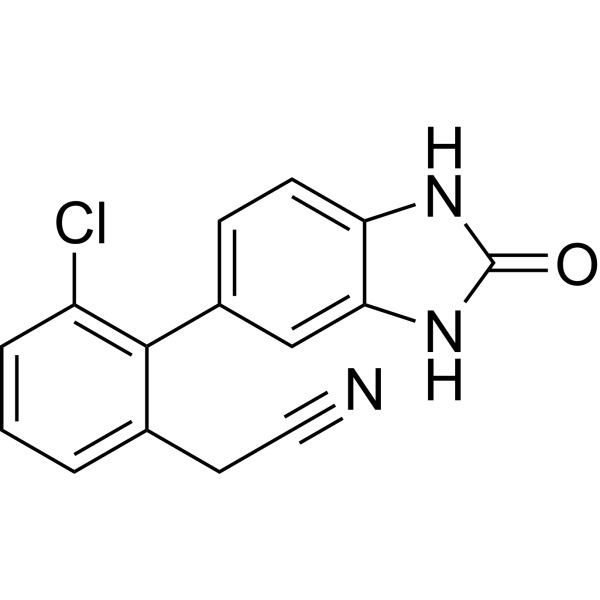
-
- HY-161663
-
|
|
Phosphodiesterase (PDE)
|
Cardiovascular Disease
|
|
Phosphodiesterase-IN-2 (Compound C7) is a selective, orally active inhibitor for phosphodiesterase 10A (PDE10A), with an IC50 of 11.9 nM. Phosphodiesterase-IN-2 improves the stability of liver microsomes, and lowers BBB permeability. Phosphodiesterase-IN-2 exhibits good pharmacokinetic characters, and attenuates isoprenaline (HY-108353)-induced cardiac hypertrophic in mouse models .
|
-

-
- HY-144272
-
-
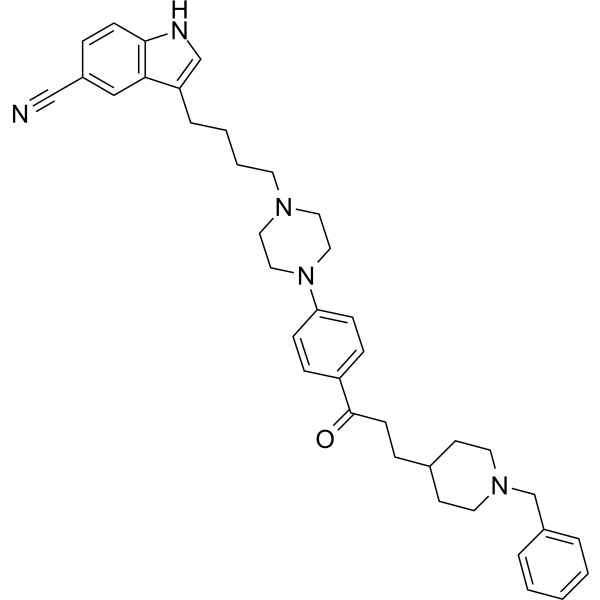
-
- HY-A0168R
-
|
|
Adenosine Receptor
|
Cardiovascular Disease
|
|
Regadenoson (Standard) is the analytical standard of Regadenoson. This product is intended for research and analytical applications. Regadenoson (CVT-3146) is a selective A2A adenosine receptor agonist and vasodilator that increases coronary blood flow, can be used in study of myocardial perfusion imaging. Regadenoson also increases the permeability of the blood-brain barrier (BBB) in rodents, can be used to study increased delivery of agents to the human CNS .
|
-

-
- HY-B1102
-
|
Direct Blue 53; T-1824; C.I. 23860
|
EAAT
iGluR
|
Neurological Disease
|
|
Evans Blue (Direct Blue 53) is a potent inhibitor of L-glutamate uptake via the membrane bound excitatory amino acid transporter (EAAT). Evans Blue is a L-glutamate and kainate receptor-mediated currents inhibitor. Evans Blue has a strong affinity towards serum albumin, making it a high molecular weight protein tracer. Evans Blue is also used to study BBB (blood-brain barrier) permeability .
|
-

-
- HY-149984
-
|
|
Monoamine Oxidase
|
Neurological Disease
Inflammation/Immunology
|
|
MAO-B-IN-21 is an excellent MAO-B inhibitor with antioxidant activity and anti-Aβ aggregation activity. MAO-B-IN-21 also exhibits metal-ion chelating ability, anti-neuroinflammation (NO, TNF-α), neuroprotective activity and BBB permeability. MAO-B-IN-21 significantly improves the memory and cognitive impairment in Aβ1-42 induced Alzheimer's disease mice model .
|
-

-
- HY-144828
-
|
|
RIP kinase
Mixed Lineage Kinase
Necroptosis
|
Cancer
|
|
RIP1/RIP3/MLKL activator 1 (Compound 6i) is a potent anti-glioma agent. RIP1/RIP3/MLKL activator 1 induces necroptosis through RIP1/RIP3/MLKL pathway. RIP1/RIP3/MLKL activator 1 exerts acceptable BBB permeability .
|
-

-
- HY-149247
-
|
|
5-HT Receptor
Dopamine Receptor
|
Neurological Disease
|
|
Antipsychotic agent-2 (Compound 11) is a potent antipsychotic agent. Antipsychotic agent-2 shows affinities for 5-HT1A, 5-HT2A, 5-HT2C, D2 and H1 receptors with Kis of 56.6, 66.7, 552, 596 and 1140 nM, respectively. Antipsychotic agent-2 has BBB permeability .
|
-
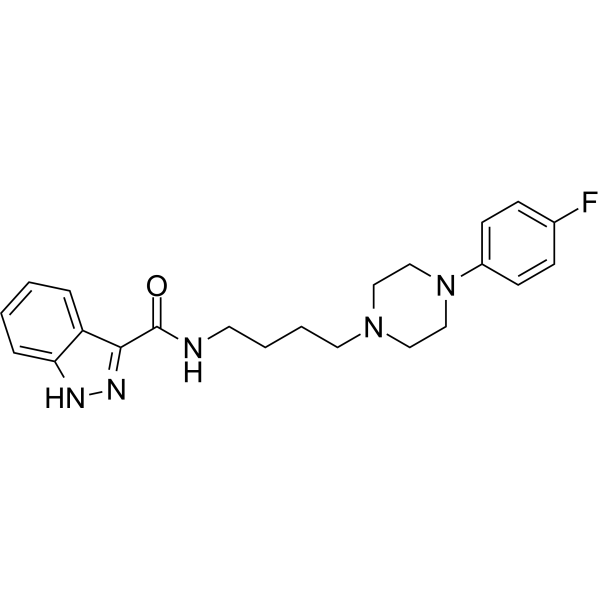
- HY-124582
-
|
|
Autophagy
mTOR
|
Cancer
|
|
NEO214 is an autophagy inhibitor and a covalent conjugate of the PDE4 inhibitor Rolipram (HY-16900) and perillyl alcohol (HY-N7000). It has anti-cancer activity and blood-brain barrier (BBB) permeability. Over sex. NEO214 prevents autophagy-lysosome fusion, thereby blocking autophagic flux and triggering glioma cell death. The process involves mTOR activation, andTFEB(Transcription Factor EB) aggregation. NEO214 inhibitionMacroautophagy/autophagy in glioblastoma cells has the potential to overcome chemotherapy resistance in glioblastoma .
|
-

- HY-161643
-
|
|
Cholinesterase (ChE)
Keap1-Nrf2
|
Neurological Disease
Inflammation/Immunology
|
|
S21-1011 is a selective inhibitor for butyrylcholinesterase (BChE), with IC50 of 0.059 and 0.162 μM, for eqBChE and hBChE, respectively. S21-1011 exhibits good blood-brain barrier (BBB) permeability and good pharmacokinetic characters. S21-1011 exhibits anti-inflammatory activity through activation of keap1-Nrf2-ARE pathway (EC50 is 23.48 μM for antioxidant element ARE activation), ameliorates cognitive impairment in murine Alzheimer’s disease model .
|
-

- HY-150563
-
|
|
Monoamine Oxidase
Amyloid-β
|
Neurological Disease
Inflammation/Immunology
|
|
Neuroinflammatory-IN-2 is a potent anti-neuroinflammatory agent with an IC50 value of 10.30 μM for MAO-B, and 96.33% inhibition of Aβ1-42 aggregation at 25 μM. Neuroinflammatory-IN-2 has neuroprotective activity in H2O2-induced PC-12 cell injury. Neuroinflammatory-IN-2 also has biometal chelating abilities, antioxidant activity, anti-neuroinflammatory activity and appropriate BBB permeability. Neuroinflammatory-IN-2 can be used for researching Alzheimer’s disease .
|
-
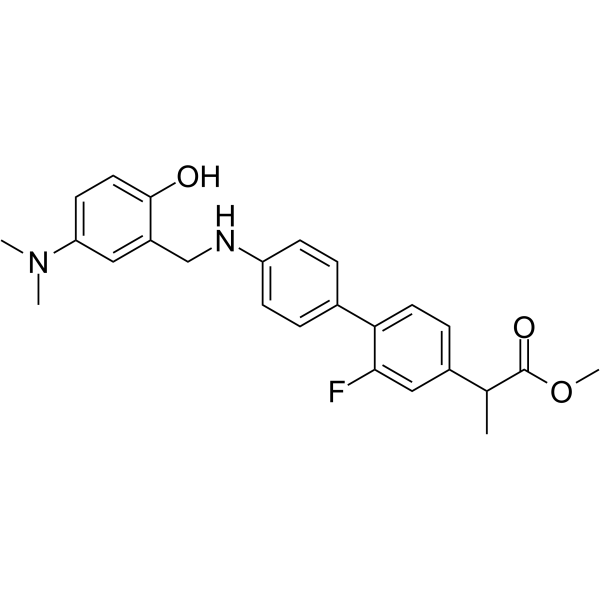
- HY-149090
-
|
|
Cholinesterase (ChE)
Monoamine Oxidase
|
Neurological Disease
|
|
AChE/BuChE/MAO-B-IN-2 (compound 4b) is a potent AChE/BuChE inhibitor and showed good blood brain barrier (BBB) permeability in vitro with an IC50 value of 5.3 μM, 12.4 μM, 1.9±0.08 μM, for AChE, BuChE, huMAO-B, respectively. AChE/BuChE/MAO-B-IN-2 (compound 4b) can inhibit excess AChE/BuChE in Alzheimer's disease (AD) brain. AChE/BuChE/MAO-B-IN-2 (compound 4b) can be used in anti-Alzheimer's research .
|
-

- HY-A0168S
-
|
CVT-3146-d3
|
Adenosine Receptor
|
Cardiovascular Disease
Cancer
|
|
Regadenoson-d3 is the deuterium labeled Regadenoson. Regadenoson (CVT-3146) is a potent and selective A2A adenosine receptor agonist, with Kis of 290 and 1120 nM for rat and pig adenosine A2A receptor, respectively. Regadenoson is selective for the adenosine A2A receptor over adenosine A1 and A2B receptors, and shows 13-fold selectivity over the human adenosine A1 receptor. Regadenoson is a vasodilator stress agent has shifted the landscape of vasodilator myocardial perfusion imaging. Regadenoson increases blood-brain barrier (BBB) permeability in rodents[1][2][3].
|
-

- HY-139604
-
|
|
Apoptosis
|
Cancer
|
|
PCC0208017 is a microtubule affinity regulating kinases (MARK3/MARK4) inhibitor with IC50s of 1.8 and 2.01 nM, respectively. PCC0208017 has much lower inhibitory activity against MARK1 and MARK2, with IC50s of 31.4 and 33.7 nM, respectively. PCC0208017 suppresses glioma progression in vitro and in vivo. PCC0208017 disrupts microtubule dynamics and induces G2/M phase cell cycle arrest and cell apoptosis. PCC0208017 demonstrates robust antitumor activity in vivo and displays good BBB permeability .
|
-

- HY-145833A
-
|
|
Epoxide Hydrolase
Cholinesterase (ChE)
|
Neurological Disease
Cancer
|
|
sEH/AChE-IN-4 (compound (+)-15) is a potent and BBB-penetrated dual inhibitor of sEH (soluble epoxide hydrolase) and AChE (acetylcholinesterase), with IC50 values of 3.1 nM (hsEH), 1660 nM (hAChE), 179 nM (hBChE, human butyrylcholinesterase), 14.5 nM (msEH), and 102 nM (mAChE), respectively .
|
-

- HY-145833
-
|
|
Epoxide Hydrolase
Cholinesterase (ChE)
|
Neurological Disease
Cancer
|
|
sEH/AChE-IN-3 (compound (−)-15) is a potent and BBB-penetrated dual inhibitor of sEH (soluble epoxide hydrolase) and AChE (acetylcholinesterase), with IC50 values of 0.4 nM (hsEH), 1.94 nM (hAChE), 615 (hBChE, human butyrylcholinesterase), 4.3 nM (msEH), and 2.61 nM (mAChE), respectively .
|
-
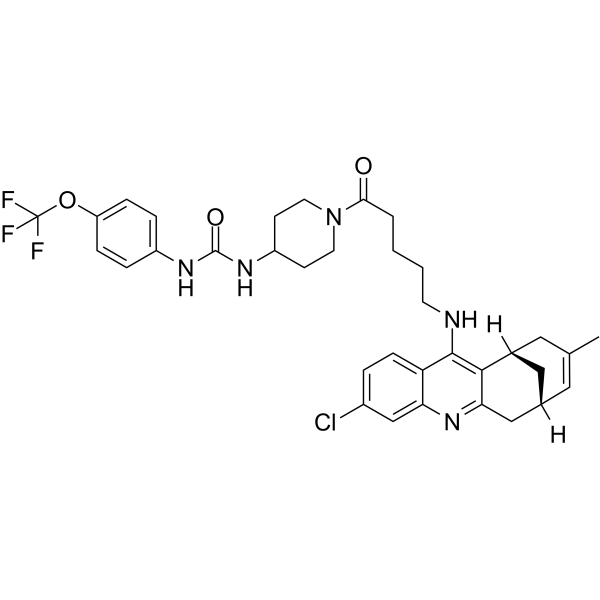
- HY-144392
-
|
|
Cholinesterase (ChE)
|
Neurological Disease
|
|
AChE/BuChE-IN-1 (Compound 1), a chrysin derivative, is a selective butyrylcholinesterase (BuChE) inhibitor with an IC50 of 0.48 μM. AChE/BuChE-IN-1 inhibits acetylcholinesterase (AChE) with an IC50 of 7.16 μM. AChE/BuChE-IN-1 shows strong scavenging ·OH activities with a IC50 of 0.1674 μM. AChE/BuChE-IN-1 inhibits reactive oxygen species (ROS), Aβ1-42 aggregation (self-, Cu2+-induced, AChE-induced). AChE/BuChE-IN-1 has high BBB permeability and bioavailability and low cell toxicity. AChE/BuChE-IN-1 has the potential for Alzheimer' disease (AD) research .
|
-

-
-
HY-L028
-
|
|
866 compounds
|
|
The blood-brain barrier (BBB) is the complex network of brain microvessels. It protects the brain from the external bloodstream environment and supplies the brain with the required nutrients for normal function. However, blood-brain barrier is also the obstacle to deliver beneficial drugs to treat CNS (central nervous system) diseases or brain tumors, as it has the least permeable capillaries in the entire body due to physical barriers (tight junctions). Therefore, it is crucial to discover drugs which can cross this barrier for the treatment of brain-based diseases, such as Alzheimer’s disease (AD), Parkinson’s disease (PD) and epilepsy.
MCE offers a unique collection of 866 compounds with confirmed CNS-Penetrant property. It’s a useful tool for the discovery of drugs used for brain diseases, such as brain tumors, mental disorders, and neurodegenerative diseases.
|
| Cat. No. |
Product Name |
Type |
-
- HY-128868G
-
|
|
Fluorescent Dyes/Probes
|
|
FITC-Dextran (MW 150000) is a fluorescent probe for fluorescein isothiocyanate (FITC) dextran (Ex=491 nm; Em=518 nm). FITC-Dextran (MW 150000) can be used as a marker to reveal heat shock-induced cell damage and to study the early and late stages of apoptosis. FITC-Dextran (MW 150000) can be used in perfusion studies in animals or in fluorescence microlymphography, to study processes that affect the permeability of the blood brain barrier (BBB) . FITC-Dextran (MW 150000) can be used as fluorescent probe to study cell permeability .
|
-
- HY-128868
-
|
|
Fluorescent Dyes/Probes
|
|
FITC-Dextran (MW 10000) is a fluorescent probe for fluorescein isothiocyanate (FITC) dextran (Ex=495 nm; Em=525 nm). FITC-Dextran (MW 10000) can be used as a marker to reveal heat shock-induced cell damage and to study the early and late stages of apoptosis. FITC-Dextran (MW 10000) can also be used for cell permeability studies, such as blood-brain barrier permeability and determination of the extent of blood-brain barrier disruption .
|
-
- HY-128868A
-
|
|
Fluorescent Dyes/Probes
|
|
FITC-Dextran (MW 4000) is a fluorescent probe for fluorescein isothiocyanate (FITC) dextran (Ex=495 nm; Em=525 nm). FITC-Dextran (MW 4000) can be used as a marker to reveal heat shock-induced cell damage and to study the early and late stages of apoptosis. FITC-Dextran (MW 4000) can also be used for cell permeability studies, such as blood-brain barrier permeability and determination of the extent of blood-brain barrier disruption .
|
-
- HY-128868D
-
|
|
Fluorescent Dyes/Probes
|
|
FITC-Dextran (MW 40000) is a fluorescent probe for fluorescein isothiocyanate (FITC) dextran (Ex=495 nm; Em=525 nm). FITC-Dextran (MW 40000) can be used as a marker to reveal heat shock-induced cell damage and to study the early and late stages of apoptosis. FITC-Dextran (MW 40000) can also be used for cell permeability studies, such as blood-brain barrier permeability and determination of the extent of blood-brain barrier disruption .
|
| Cat. No. |
Product Name |
Type |
-
- HY-B1102
-
|
Direct Blue 53; T-1824; C.I. 23860
|
Cell Assay Reagents
|
|
Evans Blue (Direct Blue 53) is a potent inhibitor of L-glutamate uptake via the membrane bound excitatory amino acid transporter (EAAT). Evans Blue is a L-glutamate and kainate receptor-mediated currents inhibitor. Evans Blue has a strong affinity towards serum albumin, making it a high molecular weight protein tracer. Evans Blue is also used to study BBB (blood-brain barrier) permeability .
|
| Cat. No. |
Product Name |
Target |
Research Area |
-
- HY-105155
-
|
RMP 7
|
Bradykinin Receptor
|
Cancer
|
|
Lobradimil (RMP 7), a synthetic bradykinin analog, is a potent and selective bradykinin B2 receptor agonist (Ki: 0.54 nM). Lobradimil increases the permeability of the BBB. Lobradimil can be used in the research of brain tumors .
|
-
- HY-149941
-
|
|
Neurotensin Receptor
|
Neurological Disease
|
|
hNTS1R agonist-1 (Compound 10) is a BBB permeable hNTS1R full agonist (Ki: 6.9 nM) . hNTS1R agonist-1 increases motor function and memory in a mouse model of Parkinson's disease (PD). hNTS1R agonist-1 is a Neurotensin(8-13) analog and is a neuroprotective agent .
|
-
- HY-P2342
-
|
|
Peptides
|
Neurological Disease
|
|
Angiopep-Bim BH3 hydrochloride, a BBB penetrated peptode, could be used to investigate the permeability of CNS therapeutics .
|
-
- HY-P10153
-
|
|
Peptides
|
Others
|
|
gH625 is a cell-penetrating viral peptide which is a part of glycoprotein H of Herpes simplex virus type I. gH625 is able to cross the cell membrane and to transport many conjugated cargoes into the cytosol. gH625 is permeable to the blood-brain barrier (BBB) and can enter the rat brain in vivo without toxic effects. gH625 can be used for siRNA delivery research .
|
| Cat. No. |
Product Name |
Category |
Target |
Chemical Structure |
| Cat. No. |
Product Name |
Chemical Structure |
-
- HY-N6685S1
-
|
|
|
3-Acetyldeoxynivalenol- 13C17 is the 13C labeled 3-Acetyldeoxynivalenol (HY-N6685) . 3-Acetyldeoxynivalenol, a trichothecene mycotoxin deoxynivalenol (DON) acetylated derivative , is a blood-brain barrier (BBB) permeable mycotoxin .
|
-

-
- HY-A0168S
-
|
|
|
Regadenoson-d3 is the deuterium labeled Regadenoson. Regadenoson (CVT-3146) is a potent and selective A2A adenosine receptor agonist, with Kis of 290 and 1120 nM for rat and pig adenosine A2A receptor, respectively. Regadenoson is selective for the adenosine A2A receptor over adenosine A1 and A2B receptors, and shows 13-fold selectivity over the human adenosine A1 receptor. Regadenoson is a vasodilator stress agent has shifted the landscape of vasodilator myocardial perfusion imaging. Regadenoson increases blood-brain barrier (BBB) permeability in rodents[1][2][3].
|
-

Your information is safe with us. * Required Fields.
Inquiry Information
- Product Name:
- Cat. No.:
- Quantity:
- MCE Japan Authorized Agent:




































































